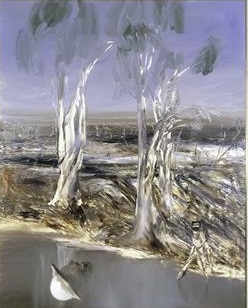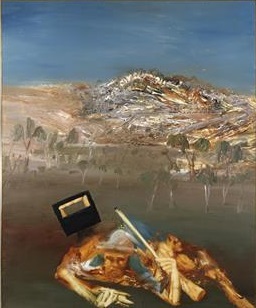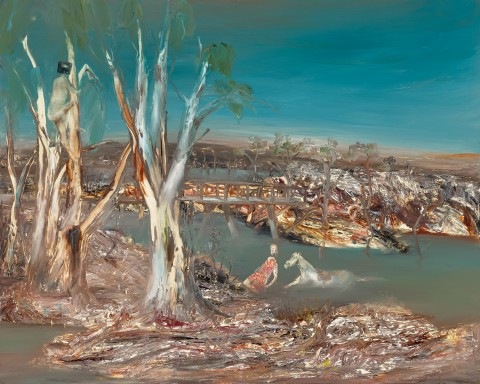CROSSING THE RIVER, 1964
SIDNEY NOLAN
oil on composition board
122.0 x 152.5 cm
signed with initial lower right: N
signed and dated lower left: 30 oct 1964 / nolan
signed and inscribed verso: nolan / Not for Sale / Private Collection / to Sydney
Private collection, United Kingdom, by 1967
Waddington Galleries Ltd, London (label attached verso, stock no. B20807, as ‘Crossing the River’)
Private collection, United Kingdom
Christie’s, Melbourne, 23 November 1998, lot 122 (as ‘River’)
The Cbus Collection of Australian Art, Melbourne, acquired from the above
possibly: Sidney Nolan Retrospective Exhibition, Ferens Art Gallery, Kingston Upon Hull, United Kingdom, 8 – 20 September 1970, cat. 40
(What's so funny 'bout) Peace, Love and Understanding, Bayside Arts and Cultural Centre, Melbourne, 22 June – 25 August 2013
Imagining Ned, Bendigo Art Gallery, Victoria, 28 March – 28 June 2015
Colour and Movement, Benalla Art Gallery, Victoria, 19 February – 9 June 2016
on long term loan to Geelong Gallery, Victoria
Lynn, E., Sidney Nolan – Myth and Imagery, Macmillan, London & Melbourne, 1967, pl. 52, pp. 15, 54, 81 (illus., as ‘River’)
Nainby, B., Stanhope, Z., and Furlonger, K., The Cbus Collection of Australian Art, in association with Latrobe Regional Gallery, Melbourne, 2009, pp. 15, 105 (illus.), 228
Policeman floating in the river, 1964, oil on hardboard, 152.0 x 122.0 cm, in the collection of the Art Gallery of New South Wales, Sydney
Kelly and policeman, 1964, oil on hardboard, 152.0 x 122.0 cm, in the collection of the Art Gallery of New South Wales, Sydney
220234 SIDNEY NOLAN.jpg

All rights reserved, DACS/Copyright Agency
The Ned Kelly paintings from 1964 are amongst Sidney Nolan’s most psychologically penetrative with their mixture of tragedy, dreamlike narrative and autobiography. The saga of Kelly’s life and death loomed large in Nolan’s imagination to the point that he became a form of spiritual doppelgänger. The artist’s colleague Albert Tucker addressed letters to him starting ‘Dear Ned’, and, as the English critic and broadcaster Eric Newton noted, ‘Nolan knows, as well as Hogarth did, how to create a character in visual terms, place him in his environment, surround him with adventures and follow him, like the hero of an epic, from torture to triumph and from triumph to death.’1 Whilst Kelly and his companions appear at numerous points in Nolan’s career, it is generally agreed that there were three main sequences. The first was painted between 1945 and 1947 at the Melbourne farmhouse ‘Heide’ with his patron Sunday Reed as collaborator. This group remains his best known, with its irreverent folk-art depiction inspired by ‘Kelly’s own words, and Rousseau, and sunlight’2 as it follows the narrative cycle of the Kelly Gang to its destruction in 1880. The second, from the mid-1950s, is more sombre, a direct result of Nolan’s encounters with droughts in Western Queensland and a damaged European landscape that still bore the scars of World War Two. Nolan would later reflect that ‘(t)he concept of the hero [had] been doomed by the European experience – from Nietzsche onwards, culminating in Hitler.’3 For the first time, Kelly struggles through the landscape bearing visible wounds and, in places, is transformed by Nolan into a universal ‘man of sorrows.’ The third sequence, of which River, 1964, is a significant example, was created over a three-month period towards the end of that year.
The trajectory of Nolan’s paintings from 1964 began as a direct consequence of his visit to Antarctica in the middle of January that year. In February, he re-visited the Wimmera region of north-west Victoria in the company of critic Robert Hughes, then travelled by car from Sydney to Adelaide with Russell Drysdale and Hal Missingham to attend the Festival of Arts in Adelaide where a major exhibition of his African paintings from the previous year was being held at Bonython Galleries. In April, he returned to England and three months later was reported to be embarking on ‘an exciting new venture. In his Putney studio he is painting a series of forty pictures, each four feet square, of the scenes he saw in the Antarctic earlier this year.’4 Whilst defined by the artist’s use of oil colours mixed with Rowney’s new gel medium and applied with squeegees, these haunting images of the frozen, hostile environment were also augmented by swathes of thick paint applied with brushes of varying scale, and it is this latter approach which distinguishes Crossing the River and its companions. Coincidentally, the original Kelly series were exhibited at QANTAS House in Piccadilly that June to wide acclaim, before touring to Edinburgh and Paris. These works were still owned by John and Sunday Reed and, despite his continuing estrangement from the pair, Nolan saw the exhibition, with the re-exposure after nearly two decades providing further impetus for Nolan to revisit the theme.
220234 SIDNEY NOLAN (2).jpg

All rights reserved, DACS/Copyright Agency
Following a short sequence of ‘Burke and Wills’ paintings in August, the initial Kelly appears in mid-October as a close-up of his helmeted head, inclined against an Antarctic sky.5 As the series progresses, the brush marks become more pronounced with a viscosity that at times overwhelms the central characters. The setting is usually on the muddy banks of a watercourse, identified by Nolan as being the Goulbourn River of his youth, painted in rich reds and browns. Under a hazy blue sky, Kelly is reduced to a symbolic silhouette as he encounters policemen, travellers and even his mirrored self. In Policeman floating in the river (Art Gallery of New South Wales), painted three days before Crossing the River, a wounded Kelly sits astride his horse, which drinks from the waters as a helmeted policeman drifts by. In the present work, the helmeted but otherwise naked outlaw climbs a tree near a railway bridge to observe his grey mare Music as she floats next to a figure wearing a floral-patterned dress and whose head hovers separate to its trunk. This theme tangentially alludes to the painting Steve Hart dressed as a girl, 1947, (National Gallery of Australia) where the Gang member dons female clothing as a disguise to evade police.6 In contrast to the agitated paint marks defining the land in Crossing the River, Nolan paints the water as a translucent, smooth passage, a contrast which enhances the sense that the floating figure may be a dreamlike vision visible to Kelly alone. On 16 November, Nolan revisited the same theme in Disguise (former Mertz Collection, Texas), only now the semi-naked bushranger is back on his horse as he leans towards a be-frocked and bearded man who wears a straw hat sporting a single red flower.
1. Eric Newton, ‘Review: Art and artists 1964’, The Guardian, London, 23 December 1964
2. Sidney Nolan, cited in Clark, K., McInnes, C., and Robertson, B., Sidney Nolan, Thames and Hudson, London, 1961, p.30
3. Sidney Nolan, 1964, cited in Spencer, C., ‘Speaking with Sidney Nolan: the Australian heroic dream’, Studio International, no.168, 1964, p.207
4. Poetry in Paint’, Sunday Telegraph, London, 19 July 1964
5. Another isolated Kelly image is dated 3 August 1964
6. Later re-worked as The disguise, 1955 (Art Gallery of Western Australia)
ANDREW GAYNOR
